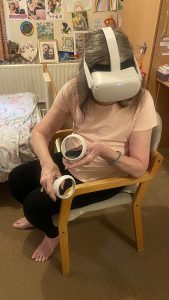In previous studies, many studies have shown that elderly people in nursing homes have very serious loneliness problems, especially during this particular period. And I’ve found some previous research on immersive experiences in the elderly. These include augmented reality and augmented reality. Then I put my focus on VR, I interviewed three groups, VR companies, nursing homes, and the elderly. Previous research has focused more on VR travel, or whether VR socializing can bring spiritual comfort to older people, ignoring what they really think. Through David’s twice-tutorials, I found that I lacked understanding of the loneliness and mental state of the elderly.
So since Unit3 started, I’ve been communicating with nursing home staff, and I’ve re-established my research. And today, I did an intervention to communicate with two old people.
The first one is of Chinese descent, she has Alzheimer’s disease, she needs 24-hour care, so her family sent her to a nursing home, her cognition has more serious problems, she can not tell the truth or not. When I saw her, she was worried about a doll, and she thought it was a real baby. The carer told me that she had a very strong need for companionship and that she did not speak English well and had communication difficulties. She was very upset in her nursing home, didn’t trust everyone around her, and always wanted her family to come and see her. Her cognitive state is not suitable for the VR experience, and the new technology will only create new confusion for her. I think the best way for her to be with her is to be with her family. (I’ll question the expert later on about this question)
The second one, who has lived in a nursing home for four years, said she enjoyed life in the nursing home and would not feel lonely, that her family was in the UK, so she would come to see her from time to time, and that her hobby was making cakes and handmade goods, and that the walls were full of handmade goods and pictures of her family. I asked her which one she preferred for phone chat, video chat, tv, or other activities, and she said she had a computer that she liked to use to watch TV shows. During the chat, she said she wanted to go to many places, such as Hawaii, so I took her to Hawaii with a VR headset, and she was very happy. And tried painting with VR. It’s a little hard to operate but she’d love to try it many times later. Then I asked her which way to accompany her preferred, whether to travel with others in VR or chat face-to-face like us. She said she liked it all and everything made her happy.
Time reason I only got feedback from two old people. After that, the nursing home staff and I had an in-depth discussion. Every old person is in a different state, and older people without cognitive impairments are more likely to use VR. It’s more like a new attempt for them to give them new sensory stimuli and give them a good mood at the moment, but whether it can ease loneliness varies from person to person, and it’s hard to tell.
So next I’ll learn more about the mental and emotional state of older people and try to communicate with psychologists or related organizations.


Hi, this is a comment.
To get started with moderating, editing, and deleting comments, please visit the Comments screen in the dashboard.
Commenter avatars come from Gravatar.